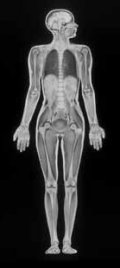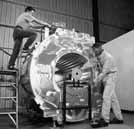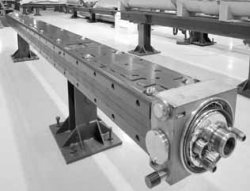 |
|
Tools for Diagnosis
Magnetic resonance imaging uses technology that began as a tool for physicists to accelerate protons to the highest energy in the world.
MRI is a technique used to produce high quality images of the inside of the human body. MRI is based on the principles of nuclear magnetic resonance, a technique used by scientists to obtain microscopic chemical and physical information about molecules.
At the heart of MRI technology are powerful magnets made of superconducting wire and cable first developed in the 1970s to build Fermilab's Tevatron.
To build the Tevatron, Fermilab brought together experts in superconductivity, physics, engineering, materials science and manufacturing. Their collaboration made superconducting magnet technology ready for a full-grown role in the new diagnostic capability created by MRI.
The ongoing development of high-field superconducting magnets, an understanding of the properties of atoms, and advances in high-speed computing combine to make magnetic resonance imaging an increasingly powerful tool for medical diagnosis and research.
|
| last modified 9/15/2001 by C. Hebert email Fermilab |
FRLsDFx9eyfrPXgV
 Advances in technology for medical diagnosis have created extraordinary new capabilities for imaging the human body. Many of medicine's most powerful diagnostic tools incorporate technology that physicists originally developed to explore the fundamental nature of matter.
Advances in technology for medical diagnosis have created extraordinary new capabilities for imaging the human body. Many of medicine's most powerful diagnostic tools incorporate technology that physicists originally developed to explore the fundamental nature of matter.
 A new generation of superconducting magnets will give physicists more powerful accelerators to unlock the deepest secrets of the universe. And a new generation of high-field superconducting MRI magnets will help unlock the secrets of the human body.
A new generation of superconducting magnets will give physicists more powerful accelerators to unlock the deepest secrets of the universe. And a new generation of high-field superconducting MRI magnets will help unlock the secrets of the human body.  A large-bore superconducting magnet, built by Intermagnetics General Corporation, destined for a magnetic resonance imaging system.
A large-bore superconducting magnet, built by Intermagnetics General Corporation, destined for a magnetic resonance imaging system.
 Fermilab's Tevatron accelerator is a four-mile circle of 1,020 superconducting magnets, 224 quadrupoles, like this one, and 796 dipoles. Building the Tevatron took enough superconducting wire to circle the earth 2.3 timesˇand created a new industry, ready to supply superconducting wire and cable for the emerging medical technology called magnetic resonance imaging.
Fermilab's Tevatron accelerator is a four-mile circle of 1,020 superconducting magnets, 224 quadrupoles, like this one, and 796 dipoles. Building the Tevatron took enough superconducting wire to circle the earth 2.3 timesˇand created a new industry, ready to supply superconducting wire and cable for the emerging medical technology called magnetic resonance imaging.